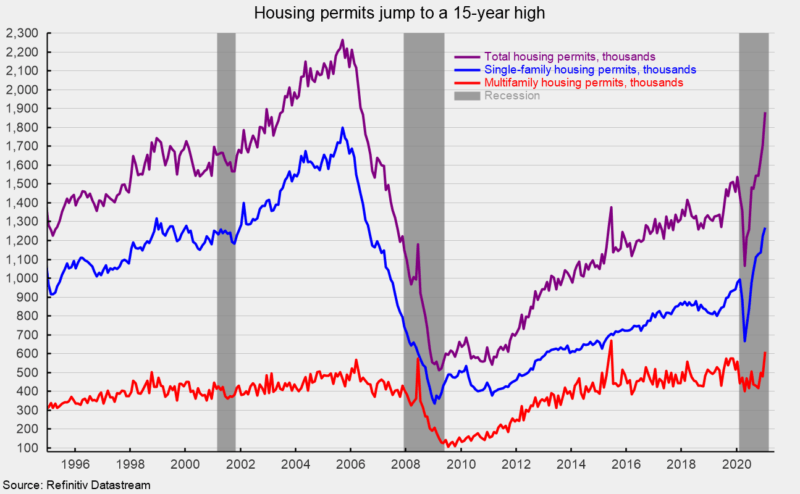Housing Permits Surge in January
Housing permits, considered a leading indicator for future construction activity and the broader economy, surged to a 15-year high in January. The jump was supported by increases in the dominant single-family category and the multifamily category. Total housing starts did fall for the month, but the drop comes on the heels of a sharp gain in the previous month. Overall, housing continues to be one of the strongest areas of the economy.
Total housing starts fell to a 1.580 million annual rate from a 1.680 million pace in December, a 6.0 percent decrease. Month-to-month volatility in housing construction can be influenced by weather conditions. From a year ago, total starts are off 2.3 percent. Still, January was the fourth-highest pace since 2006.
The dominant single-family segment fell 12.2 percent for the month to a rate of 1.162 million. Despite the drop, single-family starts are up 17.5 percent from a year ago.
Starts of multifamily structures with five or more units jumped 16.2 percent to 402,000 but are still off 35.1 percent over the past year.
For housing permits, total permits rose 10.4 percent to 1.881 million in January (see first chart). Total permits are 22.5 percent above the January 2020 level and at the highest level since May 2006. Single-family permits were up 3.8 percent at 1.269 million, the highest since August 2006 (see first chart) while permits for two- to four-family units rose 19.6 percent to 55,000 and permits for five or more units surged 28.0 percent to 557,000. Combined multifamily permits were 612,000, the highest since June 2015 and second highest since January 1990.
Among the regions in the report, total starts fell in three of the four regions. The South, the largest region by volume, lost 2.5 percent while the West fell 11.4 percent and the Midwest dropped 12.3 percent. However, the Northeast gained 2.3 percent in January.
For the single-family segment, the pattern was similar with the South off 8.8 percent, the West declining 14.9 percent, and the Midwest plunging 24.4 percent while the Northeast gained 2.5 percent.
For housing permits among the regions, total permits rose in three of the four regions. The Northeast rose 39.3 percent while the South increased 8.3 percent, the West rose 11.7 percent, but the Midwest decreased 0.8 percent.
For the single-family segment, permits rose in all four regions. For the Northeast, the increase was 12.5 percent, the South gained 1.4 percent, the West rose 7.2 percent, and the Midwest gained 4.1. Single-family housing permits for all four regions are at multi-year highs. All four regions also show strong gains from a year ago.
The National Association of Home Builders’ Housing Market Index, a measure of homebuilder sentiment, rose slightly in February. The gain reflects strong demand for housing but is offset by surging materials costs, especially lumber, and concern over regulatory issues. Overall sentiment remains relatively high.
The Housing Market Index rose to 84 in February, up from 83 in January. The three components of the index had mixed results in the latest month but generally remained at favorable levels. The current single-family sales index was unchanged at 90, the expected single-family sales index fell to 80 from 83 in the prior month, and the traffic of prospective buyers index rose to 72 from 68. On a regional basis, the four regions had mixed results in February but were also still at historically favorable levels. The Northeast index rose to 89 from 68, the Midwest index rose to 81 from 80, the South index was unchanged at 82, and the West index fell to 91 from 92.
Single-family home construction activity has recovered sharply since the April low as lockdown restrictions that impacted both construction workers and potential customers were eased. Furthermore, mortgage rates remain near all-time lows, providing support for the housing recovery though rising prices and tightening lending standards are headwinds for affordability and financing.
Housing is one of the areas that may be experiencing structural change. There appears to be sustained marginal demand for less dense suburban and rural housing as urban dwellers, primarily renters, seek alternative housing. This trend could be boosted if businesses implement permanent work from home policies, to make employees happy but also to cut down on high-cost commercial real estate, especially in high-density, high-cost cities.






